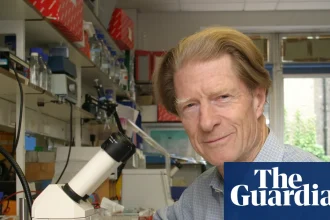The remains of a beloved saint are set to be removed from his tomb and put on display for the first time in 800 years as part of an ancient Catholic ritual.
The bones of Saint Francis of Assisi will be showcased at the basilica bearing his name in Italy from February 22 to March 22, 2026, for veneration, a traditional form of reverence and respect given to saints.
According to ancient texts, the practice of veneration originated after the martyrdom of Saint Polycarp, who was burned alive and then stabbed for refusing to worship the Roman Emperor nearly 1,870 years ago.
His followers collected his bones and treated them with great reverence, sparking the Church’s centuries-old tradition of honoring those who devoted their lives to faith and sacrifice.
St Francis’ body will be moved from its tomb in the crypt and placed at the foot of the papal altar in the lower church of the basilica.
St Francis’ bones rest inside a sealed glass urn beneath the Basilica, preserved in a controlled nitrogen atmosphere to prevent decay.
What remains are aged, yellowed skeletal fragments, the long, fragile bones of the arms and legs, the curved line of ribs, and pieces of the skull, arranged reverently within a protective casing.
When his tomb was first opened in 1818, witnesses described the skeleton as remarkably intact for its age, wrapped in remnants of a coarse woolen habit, consistent with the humble robes of the Franciscan order he founded.

The bones of St Francis of Assis are set to be put on display in Italy next year for veneration, a traditional form of reverence and respect given to saints

The saint claimed he had a vision of an angelic being, and when he came back to reality, there were crucifixion marks on his palms. The wounds appeared to be similar to those of Jesus when he was nailed to the cross
Vatican News, the official outlet of the Vatican, said: ‘The 800th anniversary of the death of Saint Francis will be a time of remembrance and renewal, a celebration of a life that ‘blossoms from the gift and offering of oneself,’ a seed ‘sown in the earth that continues to bear fruits of peace, faith, and love.’
‘The event’s motto is ‘Saint Francis Lives.’
St Francis, an Italian friar and mystic, is the patron saint of animals, the environment, ecology and Italy, known for his love of all God’s creatures and his founding of the Franciscan Order, which serves the poor and marginalized.
Born as Giovanni di Pietro di Bernardone, he was born between 1181 and 1182 to Pietro di Bernardone, a wealthy cloth merchant, and Lady Pica, who may have been French.
While his father was away on business in France, his mother named the baby Giovanni, but when Pietro returned, he changed it to Francesco, inspired by his love of France or his wife’s heritage.
In his early adulthood, Francis experienced a spiritual transformation after a series of visions and encounters with poverty.
He renounced his family’s wealth, embracing a life of simplicity, humility and service, and founded the Franciscan Order, emphasizing poverty, compassion and devotion to God.
While St Francis is renowned for his deep faith and devotion to all living things, Christians believe he performed several miracles.

His remains are hidden crypt beneath the Basilica of Saint Francis in Assisi, Italy

St Francis’ bones rest inside a sealed glass urn beneath the Basilica, preserved in a controlled nitrogen atmosphere to prevent decay
The most famous was the ‘Miracle of the Stigmata,’ which occurred after he had a vision of a Seraph, an angelic being, with six wings
As the vision faded, it left marks on his body, resembling the wounds of the crucified Christ, a phenomenon known as the stigmata.
Francis died in 1226 at the age of 44 and was canonized two years later in 1228 by Pope Gregory IX.
His body was initially interred in a hidden location to protect it from potential desecration. It remained concealed for nearly 600 years until it was rediscovered in 1818 during an excavation commissioned by Pope Pius VII.
The remains were found with several coins, beads, a ring, and a piece of iron, with his head resting on a stone. Following this discovery, the remains were carefully examined and preserved.
Over the centuries, the bones have darkened and dried, their surfaces rough and brittle with time, yet they retain a striking human form.
The Vatican is expecting a ‘large influx of faithful,’ and has asked those hoping to attend the veneration to book their visit online.
‘At the end of the veneration path, there will be a short liturgical rite, and each participant will receive a gift from the Franciscan community,’ Vatican News shared.

















